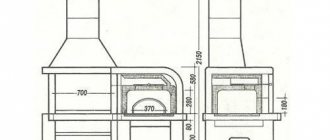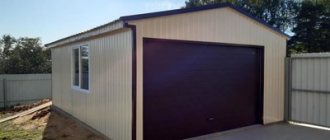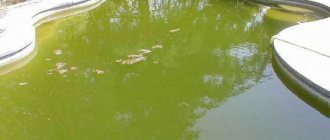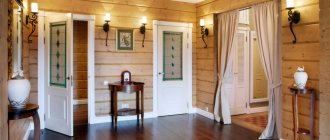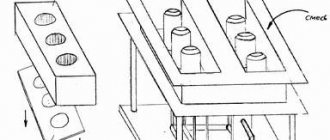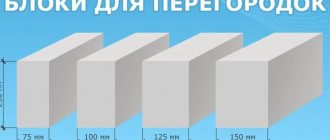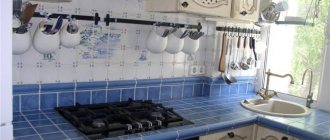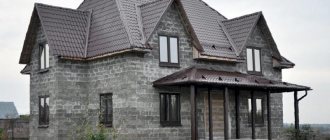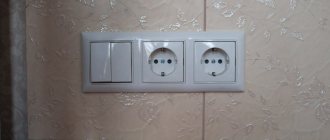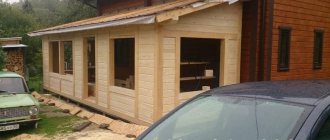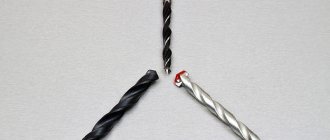The average cost of a finished swimming pool in a construction center can reach several thousand dollars. Therefore, in the hope of saving money, developers decide to build a permanent brick pool with their own hands. To implement such a project, it is not at all necessary to be a licensed builder and have many years of experience working on a construction site. However, you shouldn’t count on quick and easy results. There will be many technological nuances in the developer’s work, the observance of which is necessary in order to ensure that the pool meets a number of requirements:
1. Protection of the building from groundwater
Flooding of a brick bowl with groundwater can lead to its premature destruction. In view of this, it is important for the developer to achieve sealing of the bowl from their influence.
2. Sealing the bowl from the inside
Water will have a destructive effect on the wall material from the inside, so it is important to work on insulating the walls with special materials.
Pool design diagram
3. Focus on durability
A considerable volume of water will exert pressure on the walls of a brick pool (we are talking about 12-18 cubic meters of liquid, which a medium-sized bowl can hold). The developer must take this point into account and correctly calculate everything at the project development stage.
4. Soil heaving
The brickwork from which the walls of the bowl are built is also influenced by soil heaving forces. Therefore, if there are any defects or if the brick laying technology is not followed, the wall may collapse.
5. Organization of water drainage
It is important for developers to properly organize the water drainage system. To do this, a pit is dug next to the bowl, and a pipe from the drain hole and equipment for filtering it are placed in it.
6. Arrangement of overflow holes in the walls
To control the water level in the pool, overflow holes will need to be installed in the brick walls.
As you can see, there will be many difficulties in the process of work. A bowl built from brick consists of separate fragments and is not monolithic, so it is important to ensure its rigidity. The porous structure of the brick also adds problems to developers. Because of this, you will have to work hard on high-quality and reliable insulation of the pool both inside and outside.
Briefly about construction
The process of constructing concrete block pools is not very simple as some people think. Some choose concrete rings as walls, but this also does not simplify the task. This is due to the following features of this work:
- It is very important to properly ensure that the pool bowl does not come into contact with groundwater. Their constant exposure can negatively affect the condition of the material. In addition, in some cases they may contain unfavorable substances.
- The pool bowl must also be well sealed from the inside. Water may not have a very good effect on the condition of the blocks.
- The masonry must withstand a significant volume of water. It is worth understanding that 1 cubic meter is one ton. The average pool holds about 15 cubic meters of liquid.
IMPORTANT! There should not be any weak points in the walls, since it is in such parts that the first cracks often occur, which over time leads to leakage of the entire bowl.
Thus, building a pool from blocks with your own hands is not a very simple task. Despite this, the result is worth some hard work.
DIY concrete pool
Your own swimming pool with a concrete bowl allows you to enjoy water health treatments seasonally (if located outdoors) or year-round if located indoors. Moreover, building a concrete pool yourself is a completely solvable task, because the cost of building a hydraulic facility is determined only by your requirements for its size, configuration, materials, finishing, and internal contents.
Design
First of all, before you start building a pool, you should develop an appropriate plan. It will allow you to theoretically evaluate the possibility of constructing a given architectural object, as well as preliminary calculate the estimate for this process. If you don’t have at least an approximate diagram, you shouldn’t start taking any action to implement the idea.
The following details should be considered:
- It is necessary to determine how many people will use the pool at the same time.
- You need to think about the overall dimensions of the future object: width, depth and length. It is also worth determining the shape of the bowl. It is believed that the most optimal area is between 25 and 40 square meters. In this case, the depth should be from 1.5 to 2 meters.
- The thickness of the bottom and walls should also be thought out in advance. It should be influenced by the types of soil, the depth of groundwater, the depth of the structure, etc. The worse the soil quality, the more significant the walls should be. This also applies to the base - the deeper the bowl, the more reliable it should be.
Pool design in 3D - A communication scheme should also be developed. It must indicate the sewer system, the location of all filters used, the skimmer, stairs for entry and exit, as well as lighting, if provided.
- Special attention should be paid to methods of emergency and planned water discharge.
As soon as all the above nuances are thought out in the plan, you can immediately begin to carry out the work.
Planning
When designing a house, it is better to immediately take into account the presence of a swimming pool on the site. The arrangement of the entire local area depends on this. After all, you will need to calculate how much space the bathing container, seating area, and seating will take up.
In order to take everything into account, it is better to draw up a diagram, where it will be indicated what will be located where.
To calculate the volume of the pool, you need to take into account the number of people living in the house, and also decide for what purpose the pool is needed. It’s one thing when you just need to cool down in the heat, and quite another if you want to have a full swim.
Typically, the depth standards for a container on a site are 1.5-1.8 m. The width and length can range from 3 to 5 meters. But these figures are conditional, since when developing a project, you will have to take into account the available area and the need for other components of landscaping the local area. Some people only need a swimming pool, and a fancy one at that, while others, in addition to the tank, need a garden with fruit trees, flower beds and lawns for swimming. It is worth deciding on the preferences of all family members.
It often happens that the construction of a swimming pool has to begin when a house and other buildings already exist. In this case, you need to look for a suitable site, clear it, and perhaps move some objects to another place.
If you decide to install a pool at home, it is advisable to do it on the ground floor. And in this case, you should definitely think about its arrangement even at the stage of installing the foundation of the building.
If there is an idea to build a pool on other floors, you will need the help of specialists who will accurately calculate whether the building can withstand such a load.
Pit preparation
Before starting work on digging a pit, it is worth clearing the area of any existing vegetation. First of all, this applies to a variety of shrubs and trees, if available.
Preparing a pit manually with the help of human resources and appropriate equipment in the form of a shovel is advisable only in cases where the pool is quite small.
If the thicket of such a structure is large enough, it is best to resort to the help of an excavator. Renting this equipment often costs as much as hiring a team of workers. That is why there will be no additional expenses in this case.
It is worth noting that the dimensions of the pit should be slightly larger than the dimensions of the pool bowl . This is due to the fact that various equipment, formwork and cushions must be placed in the additional space.
IMPORTANT! To prevent the earth from collapsing from the walls of the pit, experts advise digging at a certain small angle to the vertical.
Preparatory process
As an example, let's consider the most cost-effective project that will require only your skills and strength - a pit pool with a steel base.
Before starting construction, you must have tools and building materials, as well as fittings and, of course, a steel pool design approved by specialists. Prepare:
- Ruberoid.
- Concrete grade M350-M400, frost resistance index F200, water resistance W6.
- Cement grade 400.
- Sand of medium granulation.
- Fiber fiber.
- Plasticizer.
- Reinforcement (steel, rigid - rolled I-beams, channels, angles, flexible - individual bars of smooth and periodic profile, welded or knitted meshes and frames). For the formwork and the area around the pool, reinforcement of wood origin (bamboo) is suitable.
The following tools should be available:
- Master OK.
- Meter.
- Level and plumb.
- Shovel.
- Construction tape.
- Sharp knife.
- Hacksaw.
- Container for mixing concrete.
- Construction mixer.
- Welding machine.
Preparing the base
It is worth constructing a cushion under the pool because in this case concreting will be much easier. In addition, such a base allows you to extend the life of the object. The backfill under the pool bowl should be made of sand and crushed stone. This mixture must be spread evenly along the bottom of the pit and compacted thoroughly. Its height should be between 25 and 35 centimeters.
To waterproof the bottom, you can use polyvinyl chloride (PVC), bitumen or roofing felt. These materials are lined in one or several layers. Be sure to lay them with an overlap of at least 15 centimeters. The edges of the materials need to be placed on the walls of the pit.
The procedure for performing welding work
The connection of a metal pool sheet is made in two ways: profile fasteners, classical welding. If welding work is selected, it must be done by a specialist. It is he who is responsible for the correct organization of all communications, the installation of pipes for water intake and drainage, filtration, etc. If the welding is accurate and accurate, the bowl made of steel will ideally fit into the dug pit. Each seam must be of high quality - then the tightness will be at its best. You don’t have to worry about possible leaks and problems with the operation of the pool. Welding work will be carried out in compliance with all technologies for processing sharp edges.
It is recommended to fasten steel sheets on the inside using electrochemical etching. Initially, the seams will not look very attractive - this is especially problematic on the visible top edge. But if you grind it flush with the surface, they will acquire an aesthetic appearance.
When using a fastening profile, all clamps and rivets are used according to the instructions. Ready-made kits are available for purchase in stores. They consist of fasteners, metal sheets, profiles and decorative film. But it is better to involve specialists at this stage of construction for greater guarantee. In addition, this type of work is considered quite dangerous. And it is extremely undesirable for an untrained master to do it.
where to call if someone is breaking into your apartment
The final chord is the use of a facing polymer film. It is hermetically fixed to the walls of the bowl and makes the artificial pond even more convenient to use. You can order PVC coating in almost any color range, as well as with photo printing. An excellent waterproofing material that will be a wonderful reflection of the pool.
First, the canvas is spread along the bottom of the base and leveled. To ensure a tight fit, pour a little liquid into the bottom of the bowl. Leveling is carried out from the center. After removing all “wrinkles” and folds, the PVC is fixed. All you have to do is connect the communications and enjoy the cozy water corner!
Source
Installation on the ground
Hydraulic structures should be laid during the preparation of the pit. In order for the drainage of water to be optimal, a slope should be made at a level of 4 to 8 percent, that is, about 2-4 centimeters per meter of bottom. It should be directed in the direction in which the drain will be installed.
IMPORTANT! Before installing the base, it is worth equipping all sewerage systems that would allow water to be drained from the pool. Also in the additional reception area you can place pumps, filters and other equipment.
The drainage hole must be below the water level. In this case, all the water, if necessary, can completely leave the pool bowl.
Plastic liner lined with brick
Here the situation is simple. Buy a plastic liner for the pool. They are inexpensive and come in different sizes and shapes.
Even when purchasing, consider how the water will be drained - from below, through the bottom drain, from the sides, through nozzles, or over the edge - with a skimmer. Lay pipes according to the type of water drainage when preparing the foundation for the pool.
Installation on the ground
After you have brought the bowl to the site, prepare a flat area for it. It will be necessary to remove the fertile layer of soil with vegetation and make bedding according to all the rules - as described above.
A plastic liner lined with brick is an excellent option for a pool or bathhouse and more
When draining water from the pool at the bottom, it is advisable to make a pit where the pipe should be led out. Equipment can also be located here - pump, filter, etc. With a screamer and a side drain, the pump will in any case be below the water level, so everything is organized more simply here.
Sometimes the liner is placed directly on the sand, sometimes a podium is laid out from the same brick, and the bowl is placed on it. It all depends on the type of soil. If they are not heaving, then you can put them on sand, but on clay and loam soils you will have to make at least some kind of foundation.
If you want, you can lay polystyrene foam under the brick (or on it) - there is no such thing as excess thermal insulation. You can also cover the sides of the bowl with this material, and only then cover it with brick. Great thickness is not needed - 3-5 cm is enough.
Another option for a brick-plastic pool
The waterproofing and rigidity of the walls is ensured by the liner, so there are no special requirements for the masonry and its finishing. Do as you please.
Recessed installation
The liner can be partially buried in the ground. With this option, only the depth of the pit changes. After installing the bowl (with or without thermal insulation - decide for yourself), you will need to fill the gap between the wall of the pool and the pit. This can be previously removed soil, gravel or sand.
Gravel and sand are an option for heaving soil, excavated soil is an option for normal soil. You compact the backfill and begin to cover the protruding part with bricks. Actually, that's all - finishing work remains.
Concreting the bottom and installing a base on it
To prepare the solution for concreting the day, cement is used, the grade of which is not lower than M400. A pure sand-cement mixture should not be used, since certain additives and additional water-repellent substances must be added to it, which will allow the material to withstand aggressive and quite difficult operating conditions in the future.
When preparing the solution, it is necessary to use less water than usual. The result is a semi-dry mixture. Its main advantage is that the ripening period is significantly reduced. Often it is only 7-10 days instead of 28 days.
Water-repellent concrete can be made either using a concrete mixer at home or ordered from the appropriate enterprise. But in the first case, the work must be carried out together, since in no case should premature setting of the components be allowed.
Depending on the additive, after filling you need to wait from 4 to 10 days . As soon as the concrete reaches the required characteristics, the construction of walls can begin.
Reinforcement
Reinforcing the bottom of the pool is a mandatory step. In this case, the height of the concrete layer should be about 20 centimeters.
In the reinforcement process, ribbed reinforcement is used. Its cross-section should directly depend on the operating conditions of the pool. But the diameter should not be less than 12 millimeters. The spacing of the twigs should be 20x20 or 30x30 centimeters. It can be equipped with one or two belts. The second option is often chosen in the presence of soil heaving forces.
NOTE! The reinforcement should be recessed into the concrete by 5 centimeters. That is why it is laid on bricks, which give the desired size. The distance between layers should be 10 centimeters.
Defining parameters
There are no special conditions for the size of the reservoir; a lot here depends on the preferences of the person and the capabilities of your summer cottage. So, if you have a lot of space in your dacha, then it is better to build a large metal frame pool with your own hands; if it is not much, then it is advisable to build a small one! So, for example, a small tank can be built in the following dimensions: approximately 5 meters in length and 2.5 meters in width, if larger, then the width can be doubled. When choosing a depth, you need to understand who will most often be in it - children, adults, or both. If you have children, then it is better to build a shallow “paddling pool”. For older children and adults, a pond with a depth of no more than 1.4 meters is suitable. It will be comfortable for both children and adults.
Walling
In most cases, walls are built in one row of blocks. Due to the fact that these products are quite massive, they can easily withstand the mass of water that will be in the pool.
The first two layers of blocks must be laid on ordinary concrete mortar with water-repellent properties. As for the third row, it is best to reinforce it. This sequence must be continued until the construction of the wall is completed.
The reinforcement can allow the blocks to gain greater rigidity and resistance to the mass of water in the pool. That is why other methods for constructing walls of hydraulic structures of this type do not exist.
Bathhouse made of foam blocks with a swimming pool: photo, plan, tips
In the modern world, there are many different ways to relax after a hard and busy week of work, but the most pleasant and desirable is still relaxing in the bathhouse, as well as swimming in the pool. Therefore, thousands of people who have a private plot are looking for such information on the Internet, a bathhouse made of foam blocks with a swimming pool: photos, plans, tips.
Since everyone wants to choose a suitable project and calculate how much it will cost to build such a place to hang out. It should be noted that in connection with the development of construction and the emergence of new and improved building materials, baths are built not only from logs, but also from foam blocks.
This article describes how bathhouses are built from foam blocks, as well as a lot of other information about what a bathhouse made of foam blocks with a pool is like: photos, plans, tips. But, we should start with the advantages and disadvantages of this material.
Interior decoration
You should not assume that interior finishing of a swimming pool is a fairly simple task that anyone can handle. In fact, it must be carried out in accordance with certain rules and recommendations.
First, the surface of the blocks must be impregnated with an appropriate primer. It is best to choose a deeply penetrating composition that has antibacterial properties. You can also apply an antiseptic on top of this material.
After the preparatory work has been done, it is worth putting an appropriate construction mesh on the block wall. After this, you can begin the plastering process.
If the embedded parts are installed after the walls are covered with mortar, then a special cord should be laid around the perimeter of the products . In this case, all joints must be sealed with sealant.
Waterproofing
Waterproofing the pool should be done in the same way as this work is carried out in relation to the foundations. The easiest way is to use a coating material. It is enough to apply it on the outer wall of the structure, after which you just need to wait for it to dry.
Film waterproofing material can also be used, but in this case you should choose the highest quality and most expensive products. This is due to the fact that the operating conditions of the pool are quite difficult.
In cases where the soils are quite heaving, it is necessary to fill the walls with a metal section before waterproofing work. The top can be plastered with a small layer of mortar.
What metal is best to make it from?
Buyers choose between two metal bases:
It is important that the metal is protected by a galvanic zinc coating. It prevents the penetration of moisture, which causes rust and corrosion. Metal will last longer.
Steel is suitable as the main material for metal. It is divided into galvanized and stainless steel. It is cheaper to build a pool from the first type. Stainless steel is more expensive, but stronger.
Insulation
In order to reduce the financial costs of heating water in the pool, it needs to be insulated after waterproofing work has been carried out. It is important to understand that heating several tons of water by 1 degree will require quite a lot of electricity. Due to the fact that this structure is buried in the ground, the sun will have minimal influence on it.
For thermal insulation, builders recommend using foamed polystyrene. It performs its main function well and does not absorb water. In addition, various microorganisms do not multiply in such material. Polystyrene is not eaten by insects, so it cannot be damaged in this way.
It is worth noting that it is best to choose high-density thermal insulation material. This figure must exceed 35 kilograms per square meter.
NOTE! Installation of polystyrene should be carried out in two layers. It is necessary to lay it in such a way that it overlaps the joints of each other. Additionally, water-repellent mastic should be applied to the seams.
Other Important Details
The recess around the perimeter of the pool can be filled in various ways. For this purpose, soil dug during the construction of the pit is often used. But in cases where the soil is quite heaving, crushed stone can be used. It needs to be poured into the hole and compacted quite firmly.
On top of the perimeter of the pool, you can fill it over crushed stone, on top of which you should lay a tiled covering. It is best to use a material with a matte surface. This will increase the level of safety near this hydraulic facility.
Types of blocks
Today, various types of blocks are used to build a swimming pool. First of all, this applies to the following types of material (we do not consider foam blocks, since the walls of an immersion pool must be as rigid as possible):
- Concrete blocks.
- Aerated concrete blocks.
- Cinder blocks (read about cinder block pools below)
- Expanded clay blocks.
The choice of material for the construction of walls should directly depend on operating conditions, climatic factors, as well as the availability of appropriate financial resources.
Table of advantages and disadvantages of materials for the construction of swimming pools
Each type of block used in the construction of swimming pools has its own advantages and disadvantages. That is why, before choosing this or that material, it is worth carefully analyzing these factors in order to understand how best to build the structure.
| Block types | Advantages | Flaws |
| Concrete blocks | High strength, fast construction speed, simplicity, versatility, resistance to low temperatures, ease of installation. | The need to waterproof seams, high cost, impossibility (or limited) use on heaving soils. |
| Aerated concrete blocks | Light weight, ideal geometry, fairly simple installation process. | Low frost resistance and high water absorption, the possibility of fungus spreading in the pores, the presence of shrinkage. |
| Cinder blocks | Relatively light weight and not very significant cost. | Low environmental friendliness, presence of blast furnace slag, low frost resistance, high level of water absorption. |
| Expanded clay blocks | The highest strength, high frost resistance, low water absorption, low cost, no shrinkage. | Relatively heavy weight and not very good geometry, making it difficult to build a flat wall. |
Before choosing one or another type of blocks, it is imperative to evaluate its positive and negative qualities. This will help build a better and more reliable pool that will last for quite a long period of time .
Decoration
Once plastering has been completed, you can begin installing the selected tile covering. It can be either ordinary tile or mosaic. Today, a large number of different versions of these products are sold, as a result of which anyone can create their own unique and original style of pool terrace.
IMPORTANT! Experts recommend laying tiles with water-repellent adhesive. Additionally, the walls and bottom can be painted using rubber paint. It will serve as a waterproofing layer.
Instead of tiles and sealants, a special PVC film is sometimes used. It is a glass fiber reinforced material. Due to the fact that it is sold only in finished form, such a product does not always fit the configuration of the pool.
Steel selection
When you have definitely decided to make a pool with steel walls and have decided on the size and option, then you need to decide what kind of steel you plan to make it from, the main options:
In industry, stainless and galvanized steel is used to manufacture various products. The differences between them are significant and, first of all, this is the ability not to succumb to corrosion for a certain time. Stainless steel is much more reliable in this regard and therefore costs more. Pools made of galvanized steel are more cost-effective, but people are afraid to buy such steel for pools due to some exposure to water. Otherwise, the characteristics are approximately the same:
- Eco-friendly.
- Ease of installation.
- Immunity to external influences.
Practical recommendations
There are also several practical recommendations for building a swimming pool that you should pay attention to:
- The pool should be built away from trees. This is due to the fact that their roots can damage external waterproofing and insulation. In addition, in this case there will be no need to constantly remove leaves from the water.
- The simplest and most convenient shape for a pool is square. Rectangular or with rounded corners.
- Marking the area for the pool should be done using pegs and a stretched cord.
It is imperative to pay attention to all the recommendations of experienced builders . They will make your work easier, faster and more reliable.
Steel pond. Choosing a model
Building a swimming pool on your property is not a difficult task. First you need to choose a form, type. The structure can be above ground, dug into the ground. There is also a “golden mean” when the tank is lightly sprinkled with earth. The choice of shapes is impressive. In addition to the square and rectangular classics, you can choose a round or oval bowl or build an arched vessel. The last word always remains with the owner of the site.
But why a metal pool, what are its advantages? Construction experts consider the design to be very reliable, 100% environmentally friendly, practical to use and durable. For use in the spring-summer season, it is enough to build a collapsible metal structure. With the onset of cold weather, you will remove it and install it again in the spring. This model is called a frame model.
Metal pool
When choosing the type of reservoir, the area of the land plot is taken into account. When the area is large, a rectangular reservoir of decent depth is built. But since most dachas do not have such areas, a frame pool becomes the best option.
